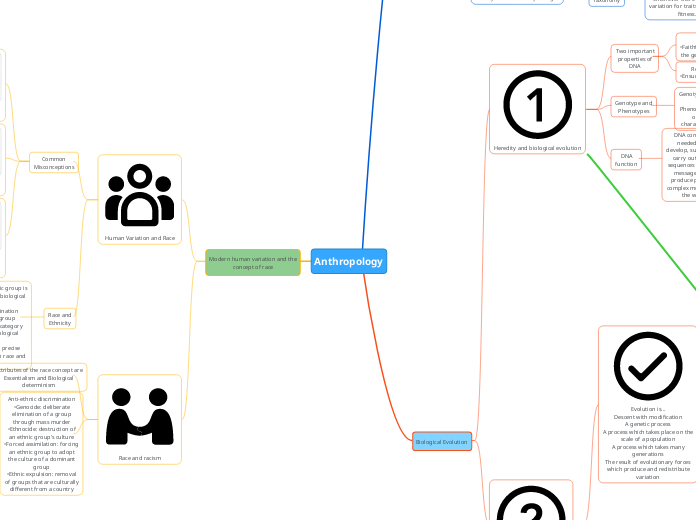Anthropology
Introduction
Introduction to Biological
Anthropology
Anthropology is the systematic of
human kind
The study of humankind, past and
present, that draws and builds
upon knowledge from the social
sciences and biological sciences,
as well as the humanities and the
natural sciences.
The Four branches of
Archaeology?
Cultural Anthropology
Study of the culture of present-day
societies
• Often in non-Western settings
Archaeological
Anthropology
Study of past human societies,
usually through material remains
(“artifacts”)
Biological Anthropology
Study of past and present:
1. Human biological evolution
2. Human biocultural variation
Linguistic Anthropology
Study of the construction and use
of language
• Structure
• Evolution
• Social and cultural context
What are humans?
Humans: a
biocultural
species
Abstract
thinking
Tool making
Speech and
communication
History of evolutionary thought
What is Evolution?
Evolution is a biological change
from generation to generation
Evolution is an observation
about the natural world
What is
Evolutionary
Theory?
Theory explains the process of this
biological change. Theory does not
ask whether evolution occurs
instead it explain how it occur.
Human
Taxonomy
Natural Selection causes
evolutionary change
whenever there is genetic
variation for traits that affect
fitness.
Biological Evolution
Heredity and biological evolution
Two important
properties of
DNA
Stability
•Faithfully preserves
the genetic message
Replicability
•Ensures inheritance
Genotype and
Phenotypes
Genotype is the genetic makeup
of an individual
Phenotypes are the observable
or detectable physical
characteristics of an organism
DNA
function
DNA contains the instructions
needed for an organism to
develop, survive and reproduce. To
carry out these functions, DNA
sequences must be converted into
messages that can be used to
produce proteins, which are the
complex molecules that do most of
the work in our bodies.
Evolution in humans
Evolution is...
Descent with modification
A genetic process
A process which takes place on the
scale of a population
A process which takes many
generations
The result of evolutionary forces
which produce and redistribute
variation
Evolutionary Forces
• Mutation
• Natural selection
• Sexual Selection
• Gene flow
• Genetic drift
• Nonrandom (assortative) mating
Natural Selection causes
evolutionary change
whenever there is genetic
variation for traits that
affect fitness
Sexual Selection:
A Special Case of Natural Selection
• The animal with the trait has
more mating opportunities
A trait that is appealing to the
opposite sex
• Limited number of eggs
• Cannot reproduce as often as
males
• Energy drained by
pregnancy/childcare
Females have more to lose than
males when mating
• Best genes to pass to offspring
• In some species, males also help
support/raise offsprin
Mutations: creating
genetic variation
• A permanent alteration in DNA –
heritable if
it occurs during meiosis
• Can improve an organism’s
chance of
surviving and passing the
beneficial change
to its offspring
• Mutations are a random source of
genetic
variation for evolutionary forces to
act upon.
Example: an allele has a 32 base-pair
deletion that makes the protein
nonfunctional.
• Lacking this protein on the surface
Genetic Drift and gene flow
Example of gene flow: he
distribution of the B Blood
Type
Example of Genetic drift: Consider
a population of rabbits with brown
fur and white fur, white fur being
the dominant allele. Due to
genetic drift, only the brown
population might remain, with all
the white ones eliminated.
Evolutionary
processes
act on
Discrete and
Continuous
traits
Mendelian traits are discrete,
controlled by alleles at one genetic
locus, their phenotypic expressions
do not overlap.
Polygenic traits are continuous,
controlled by alleles from more
than one genetic locus, each locus
making a contribution (additive).
Modern human variation and the
concept of race
Human Variation and Race
Common
Misconceptions

Humans naturally sort
into separate races.

Different races differ in
obvious ways.

Differences between
races reflect underlying
genetic differences
Race and
Ethnicity
Race is when a ethnic group is
assumed to have a biological
basis
•Racism: discrimination
against such a group
•Race is a cultural category
rather than a biological
reality
•Difficult to make precise
distinction between race and
ethnicity
Race and racism
Attributes of the race concept are
Essentialism and Biological
determinism
Anti-ethnic discrimination
•Genocide: deliberate
elimination of a group
through mass murder
•Ethnocide: destruction of
an ethnic group’s culture
•Forced assimilation: forcing
an ethnic group to adopt
the culture of a dominant
group
•Ethnic expulsion: removal
of groups that are culturally
different from a country
